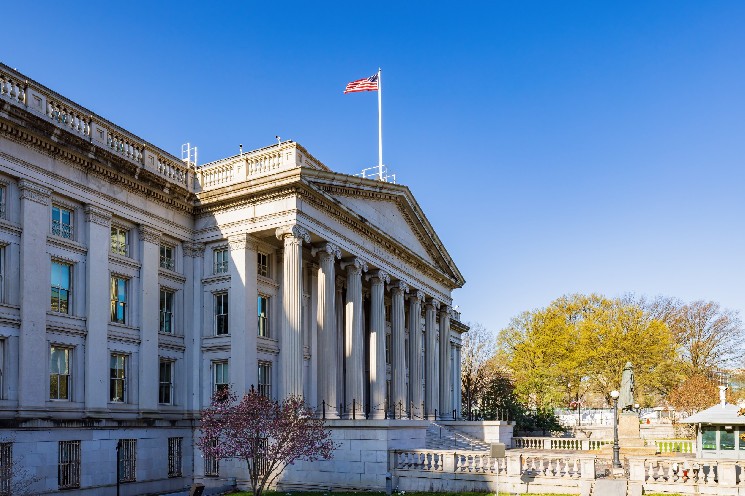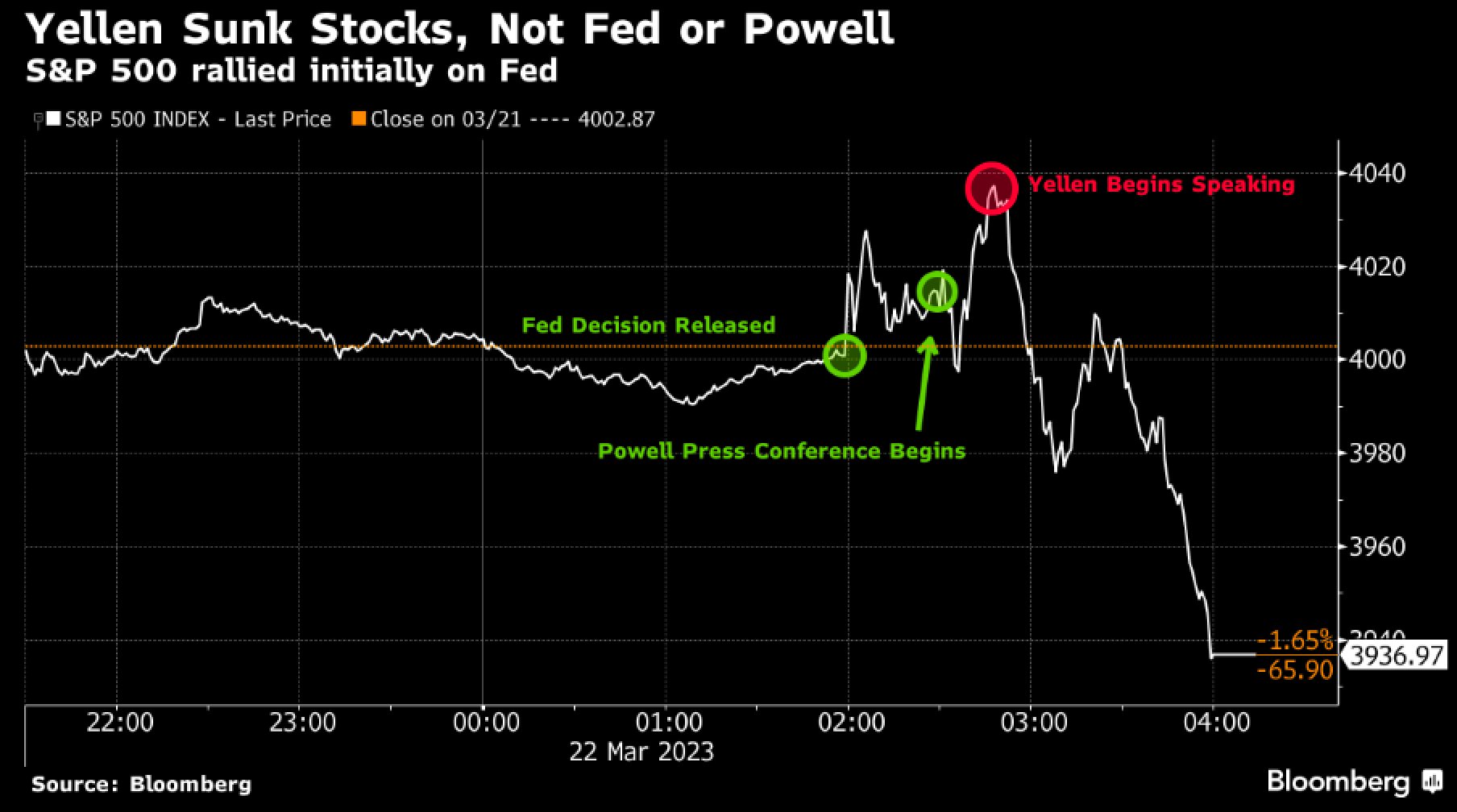Yellen Calls Unscheduled FSOC Meeting Amid Banking Turmoil

Early Friday, the US Treasury Department convened an unscheduled and closed meeting of the Financial Stability Oversight Council. Established in the aftermath of the 2008 Great Financial Crisis, the FSOC’s impromptu gathering again fuels the fire of banking contagion.
What is the monetary framework available to these institutions?
A Brewing Financial Crisis
US Treasury Secretary Janet Yellen has been on a media tour this week. On Wednesday, before the Senate Appropriations Committee, Yellen committed a big blunder. She stated, “I have not considered or discussed anything having to do with blanket insurance or guarantees of deposits.”
This contradicted Yellen’s statement on Tuesday before the American Bankers Association, saying that “similar actions could be warranted if smaller institutions suffer deposit runs that pose the risk of contagion.”
A week prior, Yellen said Americans “can feel confident” about their deposits. As one would expect, this messaging clash caused stock market turmoil.

Image credit: Bloomberg via @Schuldensuehner
On Thursday, Yellen’s modified remark reverted to the previous stance: “we would be prepared to take additional actions if warranted.” One example would be the coordinated effort to inject up to $70 billion in liquidity into the First Republic Bank.
Following the gaffe-correcting measure, Yellen summoned an unscheduled and closed-doors Financial Stability Oversight Council (FSOC) meeting on Friday. Established in 2010 as a part of the Dodd-Frank Wall Street Reform and Consumer Protection Act, FSOC consists of 10 voting members hailing from these governmental bodies:
- Chair of the Council (Treasury Secretary)
- Chairman of the Federal Reserve System
- Comptroller of the Currency
- Director of the Consumer Financial Protection Bureau
- Chairman of the Securities and Exchange Commission
- Chairperson of the Federal Deposit Insurance Corporation
- Director of the Federal Housing Finance Agency
- Chairman of the National Credit Union Administration Board
- Independent member with insurance expertise appointed by the President and confirmed by the Senate
- Independent member with financial market expertise appointed by the President and confirmed by the Senate.
Although the FSOC meeting was closed, as it addressed the delicate nature of fractional reserve banking, what framework can contain the banking contagion?
Why Did the Banking Crisis Begin?
In 2012, the current Fed Chair, Jerome Powell, was just a member of the Fed Board of Governors. At that time, he wrote this:
“Meanwhile, we look like we are blowing a fixed-income duration bubble right across the credit spectrum that will result in big losses when rates come up down the road. You can almost say that that is our strategy.”
This is one of the underlying reasons why Silicon Valley Bank went under. As the Fed started raising interest rates, the value of fixed-income securities, such as bonds (government debt), decreased. After all, the bond’s coupon rate becomes less attractive than the newly issued ones in a higher interest rate regime.
In turn, the bond’s yield decreases as a return on investment. Concurrently, this leads to the bank’s overall asset value decline. Unfortunately, Silicon Valley Bank lacked a hedge against this exposure risk, such as interest rate swaps and a more diversified portfolio.
This could be because SVB lacked a Chief Risk Officer (CRO) for eight months following the departure of Laura Izurieta last April.
But regardless of this fact, the Federal Reserve seems to expect something to break as a mechanism “to result in tighter credit conditions for households and businesses,” as noted by Powell at Wednesday’s press conference.
What is the FDIC’s Capacity to Contain Contagion?
The US banking system holds around $17 trillion in deposits, according to the latest academic paper on banking fragility. Of that amount, $7 trillion remains uninsured by the FDIC’s $250k threshold standard or 41.18%.
“Even if only half of uninsured depositors decide to withdraw, almost 190 banks are at a potential risk of impairment to insured depositors, with potentially $300 billion of insured deposits at risk.”
Due to the fastest hiking cycle in recent history, to combat inflation resulting from the Fed’s +39% M2 money supply increase, US banks’ assets declined by ~10% in value. As of December 31, 2022, FDIC reported having just $128.2 billion. This means that FDIC can only ensure 1.28% of $10 trillion in insured deposits.
This is the essence of the ‘fiat’ system, running on the concept of trust. If that trust is eroded, such a system becomes exceedingly fragile. In the aforementioned paper, researchers point to even small turbulence as sufficient kindling.
“If uninsured deposit withdrawals cause even small fire sales, substantially more banks are at risk.”
Seeing the encroaching danger, hedge fund billionaires like Bill Ackman are urging the authorities to go to unprecedented measures to make all deposits implicitly guaranteed, which Yellen implicitly hinted at.
Yesterday, @SecYellen made reassuring comments that led the market and depositors to believe that all deposits were now implicitly guaranteed. That coupled with a leak suggesting that @USTreasury, @FDICgov and @SecYellen were looking for a way to guarantee all deposits reassured… https://t.co/GqaP5LYpza
— Bill Ackman (@BillAckman) March 22, 2023
This is also why Yellen’s fumbling, through incoherent position reversals, has such a high volatility potential. Even if the US Treasury does not intend to provide “blanket insurance,” as Yellen noted on Wednesday, saying so would be powerful in a system run on governed trust.
Of course, when push comes to shove, the Federal Reserve can digitally print infinite amounts of money to backstop everything, but that would only lead to hyperinflation.






 Bitcoin
Bitcoin  Ethereum
Ethereum  Tether
Tether  USDC
USDC  TRON
TRON  Dogecoin
Dogecoin  Cardano
Cardano  Bitcoin Cash
Bitcoin Cash  Chainlink
Chainlink  Zcash
Zcash  Monero
Monero  LEO Token
LEO Token  Stellar
Stellar  Litecoin
Litecoin  Hedera
Hedera  Dai
Dai  Cronos
Cronos  Tether Gold
Tether Gold  OKB
OKB  Ethereum Classic
Ethereum Classic  KuCoin
KuCoin  Gate
Gate  Algorand
Algorand  Cosmos Hub
Cosmos Hub  VeChain
VeChain  Dash
Dash  Tezos
Tezos  TrueUSD
TrueUSD  Stacks
Stacks  IOTA
IOTA  Decred
Decred  Basic Attention
Basic Attention  Theta Network
Theta Network  NEO
NEO  Synthetix
Synthetix  Qtum
Qtum  Ravencoin
Ravencoin  DigiByte
DigiByte  0x Protocol
0x Protocol  Nano
Nano  Zilliqa
Zilliqa  Holo
Holo  Siacoin
Siacoin  Numeraire
Numeraire  Waves
Waves  Ontology
Ontology  Status
Status  BUSD
BUSD  Enjin Coin
Enjin Coin  Hive
Hive  Pax Dollar
Pax Dollar  Lisk
Lisk  Steem
Steem  Huobi
Huobi  NEM
NEM  OMG Network
OMG Network  Bitcoin Gold
Bitcoin Gold  Augur
Augur  HUSD
HUSD